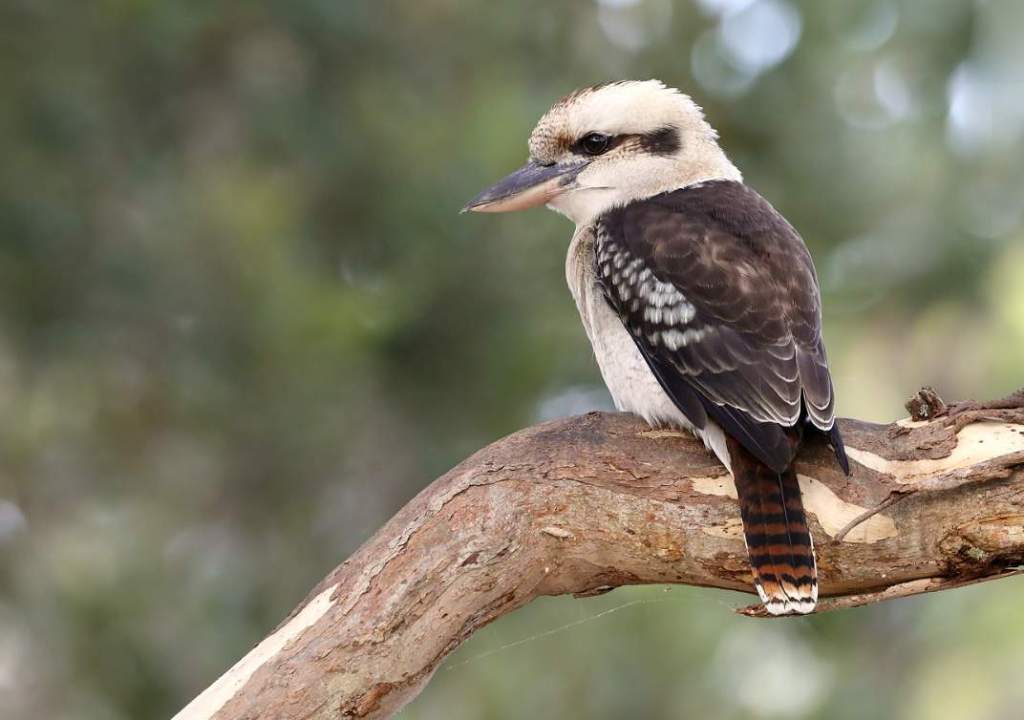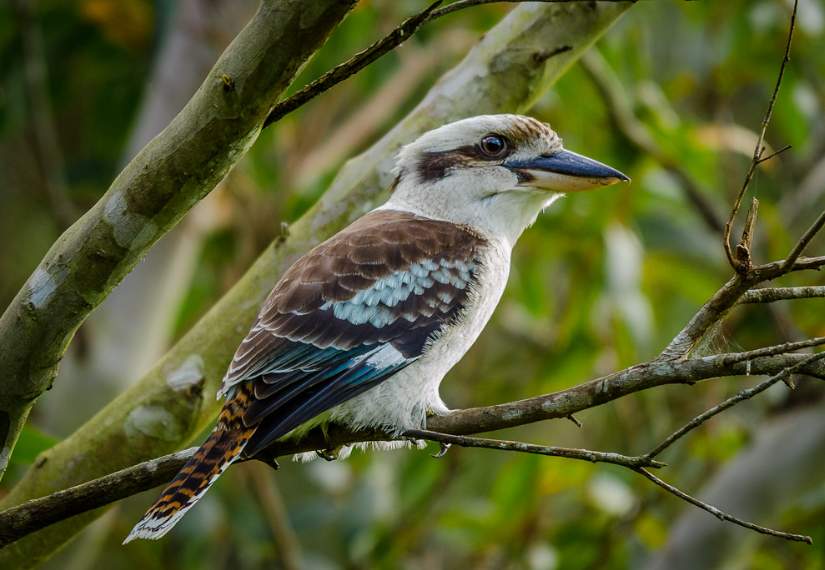Family: The Laughing Kookaburra (Dacelo novaeguineae) is the largest member of the Kingfisher subfamily Halcyoninae.
Habitat: Nesting requires tree holesoles. It can also be found in partially cleared areas, farmland with trees along roads, and along fences near wetlands. Parks and gardens are common places to find it in urban areas. Since it occupies the same territory year round, it differs from most of its relatives by being sedentary. The noisy choruses at dusk, as each group calls in turn and awaits the replies of neighboring groups, can actually be used to locate the territories before the spring breeding season when family groups adjust their territories.
A calling bird is always unmistakable, squatting on its haunches, tails raised and head thrown up as it churrs and chortles. The Laughing Kookaburra lives in woodlands and open forests. As long as there are trees big enough to contain their nests, and open patches large enough to provide hunting grounds, they can live almost anywhere in eastern Australia. Open sclerophyll forests and woodlands are the usual habitats. A sparse or open understory or grass-covered ground are more likely to support it.

Vocalizations: A Laughing Kookaburra makes six different short vocalizations, ranging from chuckles to a pronounced kooaa. In chorus, koo-hoo-hoo-hoo-haa-haa-haahaa is sung to advertise territory and is generally sung in a rolling style. In order to establish territory among family groups, the laughing kookaburra uses its “laugh”. Typically, it is heard at dawn and dusk, but it can be heard at any time of day.
Diet: The kookaburra does not have a particularly selective diet. They eat snakes, worms, mince, lizards, snakes, rodents, and even small birds occasionally, but they mostly eat insects and other invertebrates. Kingfishers hunt by perching and pounce, a characteristic method of hunting. Often no higher than 10 meters from the ground, the bulky birds sit motionless at vantage points on stumps or branches. A bird flutters down on prey, catches it in its bill, and then flies back to a perch to eat it. Their flight is buoyant between trees, with deliberate floating wingbeats.
Life span: Kookaburras can live up to 20 years under favorable conditions. Despite their low death rate, their birth rate is low, and their population turnover is very slow. A monogamous relationship lasts the rest of one’s life with the same partner.
Identification: There is a similarity between the sexes. The male is heavily flecked with blue-white over the lower back and rump. On the head, a dark brown stripe runs through each eye and over the center of the crown. A large white band runs through the base of each of the outer flight feathers that runs along the base of the mantle and wings. The mantle is dark brown, with flecks of light blue over the shoulders (coverts).
A russet brown and black barring can be seen on the lower back and rump. With pale tips, the tail is a russet-brown barred black. Dark grey-brown down flanks are faintly barred on the underparts. There is a deep brown color to the eyes. A bill with a dusky maxilla and a cream-colored mandible. The feet are pale olive-cream, while the claws are dark. An immature bird has a short, dark bill, a more strongly barred grey-brown ventrally, a brown mantle and wings edged with white, and a black rump.

Predators: Kookaburras are predators of small animals, often hunting from trees. They pounce on their prey by flying down from a branch before flying back up.
Laughter:
An aboriginal legend describes the kookaburra’s famous chorus of laughter each morning as a signal for the sky people to light the magnificent fire that illuminates and warms the earth during the day. While the legend captures the imagination, the familiar cacophony serves as an advertisement for this bold bird.
Nest: Breeding and nesting take place between September and January. The nest is usually a hole in a tree trunk or branch, or a termite mound. Nests can be found in almost any object large enough to contain an adult. The chicks excrete through an entrance hole that opens directly into a flat-floored chamber, about 500 mm across. Nesting material was not used.
Breeding: An arboreal termite nest or an unlined tree hole are common breeding places for the laughing kookaburra. The kookaburra forms permanent pairs and rears its young to independence so slowly that more than one clutch per season is unlikely. Following a short courtship in early spring, the couple raises two or three young that are fed by their parents for eight to thirteen weeks after fledging.
Rather than being forced out of the territory when they reach maturity, most young stay to defend the boundaries and raise and protect their siblings. It is not unusual for young birds to remain in this auxiliary role for four years or more; on average, they form one-third of the adult population and occupy about the same amount of territory as breeders. The mere presence of these animals reduces the birth rate by about one third by occupying areas that would otherwise be occupied by potential breeders.
While breeding pairs expend some energy to maintain their dominance, they also benefit from having to spend less time rearing the young. As well as providing up to 60 percent of the food for the nestlings, auxiliary birds contribute 32 percent to the incubation and brooding of eggs and young.
The fledglings are also taken care of by them. Kookaburras’ social system reduces breeding potential, but improves survival chances for all family members. When the auxiliaries become dominant and breed themselves, their chances of survival may increase as they are better cared for, the parents experience less strain, and the young are taken better care of.
Eggs & Incubation: One to four eggs are laid by the Laughing Kookaburra, but usually only two. The eggs are white, rounded, and 46 x 36 mm in size. Incubation begins when the female lays the first egg, about 24 days later. Five weeks later, the young fledge, fed by all members of the group.
Distribution: The Laughing Kookaburra is found in eucalypt woodlands and open forests of eastern Australia. It is found north to Cape York Peninsula, inland to the western fringes of the Great Dividing Range, and southwest to Eyre Peninsula. Introduced and established in Tasmania and southwestern Australia.
Relationship with humans: The laughing kookaburra is a common sight in suburban gardens and urban areas, and can eat from a person’s hand or rub their belly. Kookaburras often snatch people’s food without warning, by swooping in from a distance. They are often fed raw meat. Zoos often have laughing kookaburras.
Alternative Name: The bird is also known as the Kookaburra, Great Brown Kingfisher, Laughing Jackass, and Bushman’s.
Size: Laughing Kookaburra size is about 410-450 mm long, including a 50-60 mm bill.
Races: There are two races: one small on Cape York Peninsula; the other large and everywhere else.
Status: Least Concern
Related Reading: Blue-winged Kookaburra (Dacelo zeachii)







